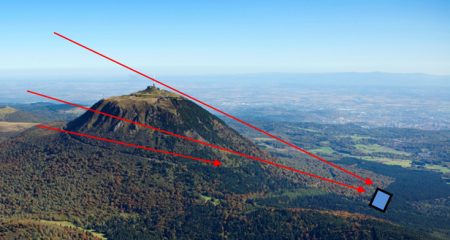Muonic tomography of volcanoes
Aims
The project aims at developing and validating a portable and robust system for achieving tomographic surveys of volcanoes by means of atmospheric muons. These particles of high energy can cross through mountains, making it possible to explore their inner structure on the same principle as X-rays at a smaller scale.
Scientific issues
Investigating the inner structure of volcanoes in order to understand their mode of emplacement
Remote and safe monitoring of active volcanoes: survey of deformations, identification of weak zones, cracks, pipes, aquifers ...,
Remote and safe monitoring of active volcanoes: survey of deformations, identification of weak zones, cracks, pipes, aquifers ...,
Methodology
(1) Measure of the flux of muons which crossed through the volcano, by means of a specific detector.
(2) Assessment of the attenuation of the muon flux along the different paths in the mountain, by comparison the flux in with free sky.
(3) Calculation of the integrated density of the rock along the different paths, on the basis of the laws governing attenuation; plot of a 2-dimentional density image.
(4) Displacements of the point of view and return to stages 1-3 for every point of view; finally a 3-dimentional image can be calculated, giving a tomography of the volcano.
(2) Assessment of the attenuation of the muon flux along the different paths in the mountain, by comparison the flux in with free sky.
(3) Calculation of the integrated density of the rock along the different paths, on the basis of the laws governing attenuation; plot of a 2-dimentional density image.
(4) Displacements of the point of view and return to stages 1-3 for every point of view; finally a 3-dimentional image can be calculated, giving a tomography of the volcano.
A long range project:
1 - Development and validation of the method at the Puy de Dôme, an extinct volcano in the French Chaîne des Puys (2010-2015)
2 - Development of an autonomous, compact and robust equipment (2013-2017)
3 - Deployment of the autonomous equipment near active volcanoes
2 - Development of an autonomous, compact and robust equipment (2013-2017)
3 - Deployment of the autonomous equipment near active volcanoes
The experiment at Puy de Dôme
Why Puy-de-Dôme?
- clear and sharp outline
- Internal structure complex, allowing testing the performances of the method
- Volcanology of the edifice sufficiently well known for making it possible to interpret the muonic images
- Very good local facilities
- Proximity of most of the involved laboratories
- Internal structure complex, allowing testing the performances of the method
- Volcanology of the edifice sufficiently well known for making it possible to interpret the muonic images
- Very good local facilities
- Proximity of most of the involved laboratories

The muon detector
The basic component of the telescope is a gas-resistive-plate-chamber (GRPC). It is a plane detector, typically of 1m2 which can record the passage of muons with a granularity of 1 cm2. The electronic system of data acquisition is able to record the position in the plane and the clock-time of every passage (a "hit"). The order of magnitude of the number of hits is about 200m-2s-1. For making a telescope, 3 or 4 similar GRPCs are assembled, parallel to each other, with a distance between 2 plans of about 50cm. When the plans are crossed over by a muon, aligned hits are simultaneously recorded on these plans. Then, after a campaign of acquisition for a few days or more, the computerized search of aligned and simultaneous hits will evidence the different tracks of the muons through the detector. Finally, provided the position of the detector is very precisely known in space, geometric considerations allow reconstruction of every muon path through the volcano itself.
Preliminary results (2012) at Grotte-Taillerie
The first stage consisted in the deployment, at the basis of Puy de Dôme, of a detector built with elements which had been made for other experiments (CALICE collaboration) and lent by other research groups.
The 3-plans detector was installed in a cave (La Taillerie) at a distance of about 1.2km from the mountain. A total of more than 12 106 tracks could be recorded between January and June 2011. The plot of the density of tracks vs direction gave a muon-shadow of the Puy de Dôme.
Then, taking account the length of the muon paths through the mountain and the attenuation of the muon flux, it was possible to draw a preliminary density model.
The length of the different muon paths through the mountain were calculated on the basis of a high resolution LiDar survey of the center of the Chaîne des Puys (project LiDarverne) acquired in March 2011 in the frame of a collaboration between physicists, volcanologists and archaeologists.
The first results evidenced a high density core beneath the summit of the volcano. It can correspond to a plug of unaltered dense lava, whereas the slopes of the volcano are covered by loose deposits.
The 3-plans detector was installed in a cave (La Taillerie) at a distance of about 1.2km from the mountain. A total of more than 12 106 tracks could be recorded between January and June 2011. The plot of the density of tracks vs direction gave a muon-shadow of the Puy de Dôme.
Then, taking account the length of the muon paths through the mountain and the attenuation of the muon flux, it was possible to draw a preliminary density model.
The length of the different muon paths through the mountain were calculated on the basis of a high resolution LiDar survey of the center of the Chaîne des Puys (project LiDarverne) acquired in March 2011 in the frame of a collaboration between physicists, volcanologists and archaeologists.
The first results evidenced a high density core beneath the summit of the volcano. It can correspond to a plug of unaltered dense lava, whereas the slopes of the volcano are covered by loose deposits.
Second experimental site at Col de Ceyssat
In January 2012, the telescope has been transported at the Auberge des Grosmanaux, a building situated at Col de Ceyssat, at the south of Puy de Dôme.
The goals were:
- being closer from the mountain
- getting a point of view at 90° from the first one.
Also, the detector had 4 plans, instead of 3 only at Grotte taillerie. This campaign of measurements was devoted to test modifications od the telescope. The total duration of the campaign(5 weeks) was not long enough for getting a sufficient number of tracks.
The goals were:
- being closer from the mountain
- getting a point of view at 90° from the first one.
Also, the detector had 4 plans, instead of 3 only at Grotte taillerie. This campaign of measurements was devoted to test modifications od the telescope. The total duration of the campaign(5 weeks) was not long enough for getting a sufficient number of tracks.
The Muray project
From June to October 2013, a detector developed by a group from Napoly has been installed at Auberge des Grosmanaux. The MuRay detector was based on scintllators. This illustrates the willing and hope of the Tomuvol collaboration that the puy de Dôme becomes a test- site for muon tomography.
The Italian researchers moved to Puy de Dôme in order to test their detector on a volcano smaller and more accessible than the Italian ones. Also, the Tomuvol and MuRay physicists wanted to compare results obtained with different experimental approaches. Analysis of the data is currently in progress.
The Italian researchers moved to Puy de Dôme in order to test their detector on a volcano smaller and more accessible than the Italian ones. Also, the Tomuvol and MuRay physicists wanted to compare results obtained with different experimental approaches. Analysis of the data is currently in progress.
The new Tomuvol telescope
The preliminary results confirmed the feasibility of the method. Also they evidenced some issues like the prominent background at low angles. Finally, the first stage conducted to the specifications for a detector specially designed for muon tomography.
Finally, a detector specifically designed for the TOMUVOL project has been built. It comprises 4 plans made of 6 similar chambers each. it was first installed in a car hangar at the eastern base of the Puy de Dôme ("local TDF"), also closer from the PdD than the Grotte-Taillerie (winter 2013-2014). During this period, various settings and adjustments were made. A lead wall was tentatively installed at the ends of the detector in order to limit the number of low-energy background tracks.
During summer 2014, the refined detector was installed at Auberge des Grosmanaux. It is currently in a phase of data-acquisition. The lead-wall was inserted in the telescope itself, between the chambers (2 on each side), in view to diffuse the weak energy muons and finally disturb the alignment of their hits on the 4 planes. This is expected to get rid of part of the background, as predicted by modelling the muon flux by means of Monte Carlo calculations.
Finally, a detector specifically designed for the TOMUVOL project has been built. It comprises 4 plans made of 6 similar chambers each. it was first installed in a car hangar at the eastern base of the Puy de Dôme ("local TDF"), also closer from the PdD than the Grotte-Taillerie (winter 2013-2014). During this period, various settings and adjustments were made. A lead wall was tentatively installed at the ends of the detector in order to limit the number of low-energy background tracks.
During summer 2014, the refined detector was installed at Auberge des Grosmanaux. It is currently in a phase of data-acquisition. The lead-wall was inserted in the telescope itself, between the chambers (2 on each side), in view to diffuse the weak energy muons and finally disturb the alignment of their hits on the 4 planes. This is expected to get rid of part of the background, as predicted by modelling the muon flux by means of Monte Carlo calculations.
Geophysics on Puy-de-Dôme
The TOMUVOL project includes the application of several different geophysical methods on a single extinct volcano which is, in the initial phase of the project, the Puy de Dôme (Chaîne des Puys, France). This is aimed at validating the muon model which will be finally obtained by comparison with more firmly established techniques. It aims also at testing the possibility of integrating data derived from different techniques in a unique computation for assessing a structural model of the mountain. The methods which have already been applied are electric resistivity tomography (ERT) and gravimetry.
Work in progress and short term projects
- Theoretical work
Reconstruction of images on the basis of the muon tracks necessitates modelization and calculations. This concerns muon production, propagation in air and in mountains, muon detection. Data acquisition and analysis is highly complex and uses sophisticated algorithms applied by important calculation means. This theoretical work is performed in parallel with th edevelopment of the telescope. Part of this work is made in the framework of 3 thesis.
- Design of a mobile and autonomous equipment
The definition and design of a mobile and autonomous telescope has been undertaken. The phase of development will take place around the Puy de Dôme. The aim of this project is to become able to deploy the telescope anywhere in the World.

